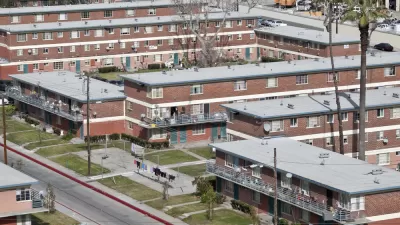Metropolitan region's make up a major part of the U.S. in terms of population and economic activity. Accordingly, the Brookings Institution was surprised to see how little of the government's first year stimulus package went to those areas.
Robert Puentes offers this analysis of the spending, including the recent TIGER grants from the Department of Transportation.
"Because our 100 largest metropolitan areas harbor two-thirds of our population and generate 75 percent of our gross domestic product, it makes sense to leverage that economic might when making infrastructure decisions. Metropolitan areas are agglomerations of innovation and human capital. Metros offer more sustainable development patterns, which are supported by a range of transportation and infrastructure choices. In that regard, metropolitan areas are also where 72 percent of the seaport tonnage arrives and departs; where 78 percent of our interstate miles are travelled; where 92 percent of air passengers and transit miles are ridden, and where 93 percent of rail passengers board.
So what do we know so far about the transportation recovery spending? Analyzing the latest Recovery.gov data we find that, overall, just 41 percent of the projects and 59 percent of the transportation spending occurred in the 100 largest metropolitan areas."
FULL STORY: TIGER’s Tale and Lessons for Stimulus Spending

Maui's Vacation Rental Debate Turns Ugly
Verbal attacks, misinformation campaigns and fistfights plague a high-stakes debate to convert thousands of vacation rentals into long-term housing.

Planetizen Federal Action Tracker
A weekly monitor of how Trump’s orders and actions are impacting planners and planning in America.

San Francisco Suspends Traffic Calming Amidst Record Deaths
Citing “a challenging fiscal landscape,” the city will cease the program on the heels of 42 traffic deaths, including 24 pedestrians.

Defunct Pittsburgh Power Plant to Become Residential Tower
A decommissioned steam heat plant will be redeveloped into almost 100 affordable housing units.

Trump Prompts Restructuring of Transportation Research Board in “Unprecedented Overreach”
The TRB has eliminated more than half of its committees including those focused on climate, equity, and cities.

Amtrak Rolls Out New Orleans to Alabama “Mardi Gras” Train
The new service will operate morning and evening departures between Mobile and New Orleans.
Urban Design for Planners 1: Software Tools
This six-course series explores essential urban design concepts using open source software and equips planners with the tools they need to participate fully in the urban design process.
Planning for Universal Design
Learn the tools for implementing Universal Design in planning regulations.
Heyer Gruel & Associates PA
JM Goldson LLC
Custer County Colorado
City of Camden Redevelopment Agency
City of Astoria
Transportation Research & Education Center (TREC) at Portland State University
Jefferson Parish Government
Camden Redevelopment Agency
City of Claremont



























